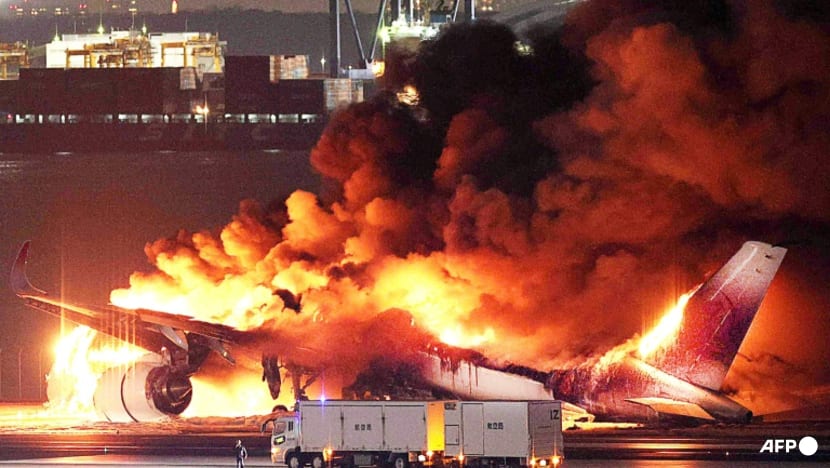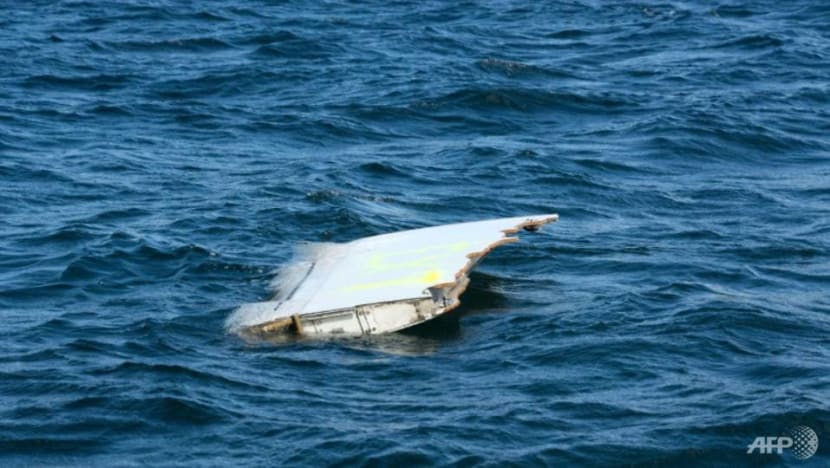How did almost 400 people safely evacuate burning Japan Airlines jet after Haneda Airport crash?
The Japan Airlines jet collided with a Coast Guard plane when landing at Tokyo’s Haneda Airport on Tuesday after flying in from the northern city of Sapporo.


This audio is generated by an AI tool.
The speed of evacuation by passengers and crew members aboard Japan Airlines JAL516 in Tuesday’s (Jan 2) accident was a miracle and a testament to the aircraft’s emergency system, said experts.
Passengers followed emergency protocols and did not try to take their belongings, while the aircraft’s exit slides also worked despite being deployed under full capacity, experts told CNA.
The aircraft had collided with a Coast Guard plane when landing at Tokyo’s Haneda Airport, after flying in from the northern city of Sapporo. All of the 367 passengers and 12 crew members evacuated the plane with no major injuries.
The light smoke in the cabin also meant passengers were not incapacitated by smoke inhalation and suffocation, and could make their way out, said experts.
Initial reports suggested that the evacuation could have been completed as quickly as 90 seconds.
Since then, more information has emerged suggesting that it might have taken as long as 18 minutes from the collision to having everyone on board safely accounted for. It's unclear how fast the actual evacuation was, but global aviation standards have a 90-second requirement.
The captain had been given permission to land but likely could not see the Coast Guard's smaller Bombardier-built Dash-8 maritime patrol plane below, airline executives said at a press conference.
Experts said the focus of the investigation would be on how both planes ended up on the same runway, with initial indications suggesting a miscommunication between air traffic control and the pilots.
EVACUATION AN "AMAZING" FEAT
Assistant professor of aviation and integrated systems engineering Shawn Pruchnicki from Ohio State University told CNA’s Asia First on Wednesday that the speed of the evacuation was “amazing”.
“I'm guessing the fact that if they really did get off in 90 seconds, it sounds like probably people did not try to grab their luggage, because that's a pretty quick time,” he said.
He explained that one major hindrance when evacuating an aircraft is typically if people try to grab their bags before departing.
Mr Desmond Ross, managing director of aviation and air transport consultancy Ireland Pegasus Aviation Advisors, said that there is a global safety certification requirement for manufacturers to prove that an aircraft under stress can be evacuated in less than 90 seconds.
This applies to all aircraft, he said, including larger ones like the Airbus A380, the world’s largest passenger aircraft.
“The flight attendants on the aircraft have done a marvellous job in opening the doors and actually mustering the passengers to get them to the doors. It's only from that moment that it got a little confusing with people trying to run down the slides instead of sliding down them,” Mr Ross told CNA’s World Tonight on Tuesday.
“But it is truly remarkable that they were able to achieve that without any major injuries.”
Mr Geoffrey Thomas, editor-in-chief of airline safety website Airlineratings.com, told CNA’s Asia Tonight that aircraft are certified up to a level whereby all passengers can exit in 90 seconds using only half the emergency slides.
“In this case, I could only see three slides deployed, and there are about 10 (exits with) five exits on either side. So this is an amazing escape (and) a miracle,” he said.
LIGHT SMOKE HELPED
Mr Ross added that modern materials used in building the aircraft also played a part in saving those on board.
He explained that earlier generations of aircraft quite often had flammable materials, including parts such as the seats.
However, photographs from the Haneda Airport accident showed that parts of the Japan Airlines plane were still intact, though charred, he said.

“It's actually a fact from so many accidents that passengers often survive the crash and then die through smoke inhalation and the after-effects from the burning of the materials on the aircraft,” Mr Ross added.
“So there's been a lot of work done over the years in removing any materials that can cause toxic fumes.”
Asst Prof Pruchnicki also noted that the relatively low amount of smoke in the cabin played a big part in helping everyone on board survive.
“That is a huge factor that makes all the difference in the world, because with these types of accidents, the amount of smoke in the cabin is what makes all the difference for the amount of time to egress,” he said.
“In other accidents we've seen, it comes in extremely thick (and) very close to the floor (so) no one can see, no one can function and everyone's passing out.”
Mr Ross also noted that the Haneda Airport accident is the first time there has been any sort of major incident involving the Airbus A350 requiring evacuation, and called it “a testament to the actual design of the emergency system on the aircraft”.
HOW THE CRASH POSSIBLY OCCURRED
Early indications have suggested a confusion of instructions between Haneda Airport’s air traffic control and the Coast Guard aircraft, causing the latter to enter the runway just as the Japan Airlines plane was touching down, said Mr Thomas.
Asst Prof Pruchnicki noted that the set-up of Haneda Airport with two parallel runways, could have led to either the landing plane or the taxiing plane being on the incorrect one.
“Where was everyone supposed to be? Which runways were you supposed to be on? Who, in fact, was supposed to be on the runway (and) who was not supposed to be on the runway? What was the quality of the communications?” he asked.
Mr Ross said that while weather and visibility could have played a part in such an accident, footage from the incident showed that the weather was “quite good (and) quite reasonable” on the day, and an aircraft approaching to land would have seen any obstruction on the runway.
On the ground, the air traffic controller would have told the Coast Guard aircraft to hold off entering the runway, he added.
“How it is that the captain of the Coast Guard aircraft actually entered the runway, is a really big question at the beginning,” said Mr Ross.
“Did he misunderstand an instruction from the air traffic controller, or was he so engrossed in his mission perhaps that he misunderstood it and didn't clearly understand that he should not enter the runway?”
The Coast Guard plane was heading to Niigata on Japan's west coast to deliver aid to people caught up in the earthquake that struck on New Year's Day.

Mr Ross added that many airports around the world now have autoland facilities, a system which takes control of the aircraft's approach and landing using autopilot.
Such a flight management system can help a plane land in blind conditions, such as heavy fog, that would previously have required the aircraft to divert to another airport, he explained.
“I'm not a hundred per cent certain whether Haneda Airport has that, but I would expect that it does … but this would still not excuse running into an aircraft that was already on the runway,” said Mr Ross.
FOCUS OF INVESTIGATION ON CRASH
Mr Thomas said that the pilot of the Coast Guard plane, the sole survivor on the aircraft albeit with serious injuries, could “help enormously to understand where the confusion has arisen”.
Five of the Coast Guard aircraft's crew had died in the accident.
The aircraft manufacturer Airbus would also be involved in the investigation, said Mr Ross, and they will be looking primarily at the aircraft’s features and aspects that could have contributed to the accident.
There will also be teams of governmental inspectors from the Japanese civil aviation authority, he added.
Central to the investigations would be the aircraft’s cockpit voice recorder and the flight data recorder, which will give investigators a clue into the final moments before the crash, said Mr Ross.

“Sometimes, you're unable to recover those recorders, in the case of aircraft like (Malaysia Airlines) MH370. If the aircraft is not found then the data recorders are not found,” he said.
“But in this case, they will be there on the runway amongst the charred wreckage and they will be serviceable. They are built to withstand something like this.”
The cockpit recorders will let investigators hear every word said by the pilots prior to and during the accident, and their conversation with the air traffic controllers, while the flight data recorder will record all the parameters of the aircraft.
The Coast Guard aircraft will also be examined very carefully in a similar manner, added Mr Ross.















